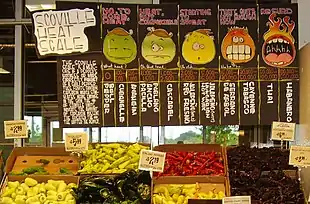Pungency
Pungency is the condition of having a strong, sharp smell or flavor.[1][2] It refers to the characteristic of food commonly referred to as spiciness, hotness or heat,[3][4][5] found in foods such as chili peppers. Highly pungent tastes may be experienced as unpleasant.

The term piquancy (/ˈpiːkənsi/) is sometimes applied to foods with a lower degree of pungency[2] that are "agreeably stimulating to the palate". Examples of piquant food include mustard and curry.
Terminology
The terms "pungent" (/ˈpʌndʒənt/ (![]() listen)) and "pungency" are rarely used in colloquial speech but are preferred by scientists as they eliminate the potential ambiguity arising from use of the words "hot" and "spicy", which can also refer to temperature and the presence of spices, respectively.[3][4][6]
listen)) and "pungency" are rarely used in colloquial speech but are preferred by scientists as they eliminate the potential ambiguity arising from use of the words "hot" and "spicy", which can also refer to temperature and the presence of spices, respectively.[3][4][6]
For instance, a pumpkin pie can be both hot (out of the oven) and spicy (due to the common inclusion of spices such as cinnamon, nutmeg, allspice, mace, and cloves), but it is not pungent. (A food critic may nevertheless use the word "piquant" to describe such a pie, especially if it is exceptionally well-seasoned.) Conversely, pure capsaicin is pungent, yet it is not naturally accompanied by a hot temperature or spices.
As the Oxford, Collins, and Merriam-Webster dictionaries explain, the term "piquancy" refers to mild pungency[2] and flavors and spices that are much less strong than chilli peppers, including, for example, the strong flavor of some tomatoes. In other words, pungency always refers to a very strong taste whereas piquancy refers to any spices and foods that are "agreeably stimulating to the palate", in other words to food that is spicy in the general sense of "well-spiced".
Applications
Pungent substances have been used as analgesics and for flavoring foods.[7]
In foods

Pungency is often quantified in scales that range from mild to hot. The Scoville scale measures the pungency of chili peppers, as defined by the amount of capsaicin they contain.
Pungency is not considered a taste in the technical sense because it is carried to the brain by a different set of nerves. While taste nerves are activated when consuming foods like chili peppers, the sensation commonly interpreted as "hot" results from the stimulation of somatosensory fibers in the mouth. Many parts of the body with exposed membranes that lack taste receptors (such as the nasal cavity, genitals, or a wound) produce a similar sensation of heat when exposed to pungent agents.
The pungent sensation provided by chili peppers, black pepper and other spices like ginger and horseradish plays an important role in a diverse range of cuisines across the world, such as Korean, Persian, Turkish, Tunisian, Ethiopian, Hungarian, Indian, Burmese, Filipino (particularly Bicolano), Indonesian, Laotian, Singaporean, Malaysian, Bangladeshi, Mexican, Peruvian, Caribbean, Pakistani, Somali, Southwest Chinese (including Sichuan cuisine), Sri Lankan, Vietnamese, and Thai cuisines.
Mechanism
Pungency is sensed via chemesthesis, the sensitivity of the skin and mucous membranes to chemical substances. Substances such as piperine and capsaicin can cause a burning sensation by inducing a trigeminal nerve stimulation together with normal taste reception. The pungent feeling caused by allyl isothiocyanate, capsaicin, piperine, and allicin is caused by activation of the heat thermo- and chemosensitive TRP ion channels including TRPV1 and TRPA1 nociceptors. The pungency of chilies may be an adaptive response to microbial pathogens.[3]
See also
References
- "Pungency". Collins English Dictionary. February 3, 2014. Retrieved February 7, 2014.
- "Merriam-Webster Dictionary: "Pungent"". Merriam-webster.com. Retrieved February 7, 2014.
- Tewksbury, J. J.; Reagan, K. M.; Machnicki, N. J.; Carlo, T. A.; Haak, D. C.; Penaloza, A. L. C.; Levey, D. J. (2008). "Evolutionary ecology of pungency in wild chilies". Proceedings of the National Academy of Sciences. 105 (33): 11808–11811. Bibcode:2008PNAS..10511808T. doi:10.1073/pnas.0802691105. PMC 2575311. PMID 18695236.
- "Chile Terminology" (PDF). Chile Pepper Institute, New Mexico State University. 2006. Archived from the original (PDF) on October 16, 2012. Retrieved September 14, 2012.
- "Chile Heat" (PDF). Chile Pepper Institute, New Mexico State University. 2006. Archived from the original (PDF) on October 16, 2012. Retrieved September 14, 2012.
- Haak, D. C.; McGinnis, L. A.; Levey, D. J.; Tewksbury, J. J. (2011). "Why are not all chilies hot? A trade-off limits pungency". Proceedings of the Royal Society B: Biological Sciences. 279 (1735): 2012–2017. doi:10.1098/rspb.2011.2091. PMC 3311884. PMID 22189403.
- Anand, P.; Bley, K. (October 2011). "Topical capsaicin for pain management: therapeutic potential and mechanisms of action of the new high-concentration capsaicin 8% patch". BJA: British Journal of Anaesthesia. 107 (4): 490–502. doi:10.1093/bja/aer260. ISSN 0007-0912. PMC 3169333. PMID 21852280.